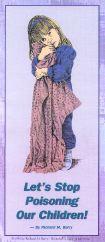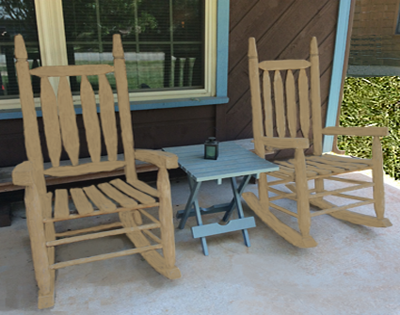 – By Richard M. Barry
– By Richard M. Barry
The following excerpts from this pamphlet are used by permission of RM Barry Publications. See below for ordering information to obtain the complete printed version of this pamphlet.
Why should three-year-old Jasson Whitley have died a lingering and horrible death after swallowing three ounces of hair conditioner? Two weeks after drinking the liquid, which contains ammonia, the little boy died.
And why should seven-month-old Adrian Gonzales have died? He crawled through a puddle of spilled laundry bleach, which gave him third-degree burns on 50 percent of his tiny body and burned his lungs from the fumes as well.
Why must these children have suffered so? If only they had never been exposed to such hazardous chemicals. Every year, five to ten million household poisonings are reported. Many are fatal, and most of the victims are children.(2) These poisonings are the result of accidental ingestion of common household substances found in just about every home.
The real tragedy is, accidents like these can easily be avoided. But most parents aren't aware that there are effective products on the market that are much safer than nationally advertised brands, and, in most cases cost less.
Household Chemicals, a Loaded Gun
The average home today contains more chemicals than were found in a typical chemistry lab at the turn of the century.
Long-Term Health Hazards of Household Products
Most poisonings happen slowly, over a long period of time, by daily exposure to toxins in the air, and toxic chemicals that come into contact with the skin. Household products are among the most toxic substances we encounter daily.
With your child's long-term health at stake, should these chemicals remain in your home?
Toxic Ingredients in Personal Care Products
Personal care products are made to put on your skin, in your hair, or in your mouth. But many ingredients used in personal care products are also toxic and can be either ingested during use (like some ingredients in mouthwash and toothpaste), or can be easily absorbed through the skin into the bloodstream (like some ingredients in soaps, lotions, creams, cosmetics, shampoos, deodorants, etc.).
Why must we expose our precious children to these poisons when there are safer alternatives available?
Indoor Air Pollution
Are you concerned about the air your child breathes? It may shock you to know that, according to an EPA Report to Congress on Indoor Air and the subcommittee hearings on the Indoor Air Quality Act of 1989, indoor air pollution is one of the nation's most important environmental health problems.
Airborne chemicals are a suspected cause of Sudden Infant Death Syndrome (SIDS) which takes the lives of thousands of infants each year.
Fortunately, parents can do something to reduce their family's exposure to airborne toxins from household products. They can simply switch brands.
To Concerned Parents
This information is not only meant to inform, but it is also a call to action. Knowing now, that the chemicals in your home can seriously harm, even kill, your child, wouldn't it be better to get them out of your home? Since there are safer, effective alternatives, is there any reason to place your child at risk another day? Don't wait! To make your home a healthier and safer place, take a look at the Guidelines for Nontoxic Living page and make as many changes as possible. See also the books listed on the MCS Resources page.
To Order Printed Copies of this Pamphlet:
Please visit the publisher's web site:








